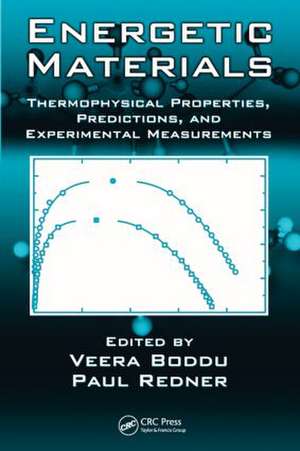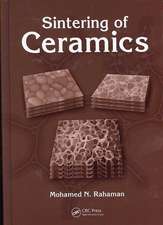Energetic Materials: Thermophysical Properties, Predictions, and Experimental Measurements
Editat de Veera Boddu, Paul Redneren Limba Engleză Hardback – 7 dec 2010
Integrate Cutting-Edge Research Sponsored by the U.S. Department of Defense
Energetic Materials: Thermophysical Properties, Predictions, and Experimental Measurements covers a variety of advanced empirical modeling and simulation tools used to explore development, performance, sensitivity, and lifecycle issues of energetic materials. Focusing on a critical component of energetic materials research— prediction of thermophysical properties—this book elucidates innovative and experimental techniques being used to:
- Apply molecular and meso-scale modeling methodologies to measure reactivity, performance, and properties of new energetic materials
- Gain insight into shear initiation at the particulate level
- Better understand the fate, transport, and overall environmental impact of energetic materials
- Evaluate the performance of new materials and assess their reaction mechanisms
Preț: 1329.36 lei
Preț vechi: 1621.18 lei
-18% Nou
Puncte Express: 1994
Preț estimativ în valută:
254.37€ • 266.30$ • 210.48£
254.37€ • 266.30$ • 210.48£
Carte tipărită la comandă
Livrare economică 07-21 aprilie
Preluare comenzi: 021 569.72.76
Specificații
ISBN-13: 9781439835135
ISBN-10: 1439835136
Pagini: 280
Ilustrații: 1/31/11 - SEE NOTES!; 137; 38 Tables, black and white; 97 Illustrations, black and white
Dimensiuni: 156 x 234 x 20 mm
Greutate: 0.52 kg
Ediția:1
Editura: CRC Press
Colecția CRC Press
ISBN-10: 1439835136
Pagini: 280
Ilustrații: 1/31/11 - SEE NOTES!; 137; 38 Tables, black and white; 97 Illustrations, black and white
Dimensiuni: 156 x 234 x 20 mm
Greutate: 0.52 kg
Ediția:1
Editura: CRC Press
Colecția CRC Press
Public țintă
Researchers and engineers working in development and manufacture of energetic and new insensitive explosive materials, materials science, chemical engineering, chemistry, and materials physics. Military and government defense labs (DoD, DoE), defense contractors, and those working with combustible materials. Mining and pyrotechnic professionals.Cuprins
Introduction: Thermophysical Properties of Explosive Materials. The History, Chemistry, and Physics of Energetic Materials. Physical Property Prediction of Energetic Materials from Molecular Dynamics Simulation. Predicting the Solvation Free Energy of 1,3,5-Triamino-2,4, 6-Trinitrobenzene (TATB) in Organic Solvents. Prediction of Physicochemical Properties of Energetic Materials via EPI Suite. Mechanisms and Kinetics of CL-20 Modes of Transformation via Alkali Hydrolysis and via Photolysis and Thermolysis Free Radical Reactions. Ignition of Metal Powder by Electrostatic Discharge. Physicochemical Property Measurements on Insensitive Munitions Compounds for Environmental Applications. Group Contribution Techniques: Predicting the Properties of Energetic Chemicals. Prediction of Physicochemical Properties of Energetic Materials. Solubility of RDX, HMX, and ε-CL20 in Supercritical Carbon Dioxide. Combustion Behavior of Nanoenergetic Material Systems.
Notă biografică
Dr. Veera M. Boddu is a senior research engineer with in the Environmental Processes Branch at the U.S. Army Engineer Research and Development Center, Construction Engineering Research Laboratory, Champaign, Illinois. Dr. Boddu has over 20 yrs of research experience with focus on studying thermophysical properties of explosive materials, and developing innovative technologies for waste streams from Army manufacturing facilities and training lands. Dr. Boddu also conducts research on catalytic degradation of new insensitive munitions explosives on nanomaterials. Dr. Boddu has published more than 35 peer reviewed journal articles, 10 Army technical reports, and 3 patents. Dr. Boddu received his B. S. from National Institute of Technology, Warangal, India, an M. S. from the Indian Institute of Technology, Kanpur, and a Ph.D. in Chemical Engineering from the University of Missouri at Columbia, all in Chemical Engineering. He is a registered professional engineer in the state of Missouri and a board-certified environmental engineer. He is an adjunct professor in the Nuclear Science and Engineering Institute at the University of Missouri at Columbia.
Paul Redner is a senior chemical engineer with the Energetics Research Branch at the U.S. Army Research, Development and Engineering Command - Armament Research, Development and Engineering Center (RDECOM-ARDEC), located at Picatinny Arsenal, New Jersey. Mr. Redner has over 11 years of research and management experience, ranging from the recrystallization and processing of high explosives such as RDX to the development of nanoscale and nanostructured materials for use in both energetic and non-energetic applications. He is currently the project officer for eight programs concentrating on the development and integration of advanced materials and nanotechnologies into Army weapons systems and spends the balance of his time performing business development duties for this technology area. Mr. Redner has published 40 peer-reviewed journal articles and has presented papers at over 36 national and international meetings. Mr. Redner received his BE in Environmental Engineering and ME in Chemical Engineering from Stevens Institute of Technology, Hoboken, New Jersey. He received his MBA from New York University – Stern School of Business, New York, New York.
Paul Redner is a senior chemical engineer with the Energetics Research Branch at the U.S. Army Research, Development and Engineering Command - Armament Research, Development and Engineering Center (RDECOM-ARDEC), located at Picatinny Arsenal, New Jersey. Mr. Redner has over 11 years of research and management experience, ranging from the recrystallization and processing of high explosives such as RDX to the development of nanoscale and nanostructured materials for use in both energetic and non-energetic applications. He is currently the project officer for eight programs concentrating on the development and integration of advanced materials and nanotechnologies into Army weapons systems and spends the balance of his time performing business development duties for this technology area. Mr. Redner has published 40 peer-reviewed journal articles and has presented papers at over 36 national and international meetings. Mr. Redner received his BE in Environmental Engineering and ME in Chemical Engineering from Stevens Institute of Technology, Hoboken, New Jersey. He received his MBA from New York University – Stern School of Business, New York, New York.
Descriere
Due to safety reasons, energetic materials are rarely studied at research facilities. Therefore, theoretical and empirical models are needed for studying the behavior of these materials. This book provides insight into the depth and breadth of these models and experimental techniques being developed for energetic materials. It presents research by U.S. Department of Defense engineers and scientists, along with their academic and industrial research partners. Some of the topics and simulations discussed can be applied to other classes of chemical compounds, such as those used in the pharmaceutical industry.






